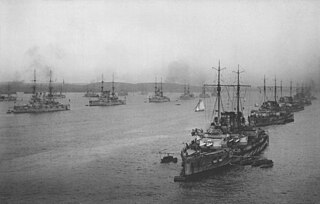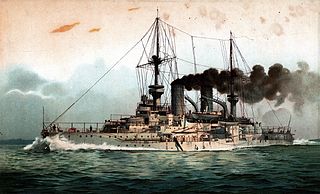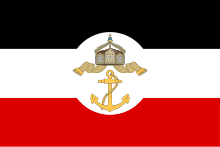
The Imperial German Navy or the Kaiserliche Marine was the navy of the German Empire, which existed between 1871 and 1919. It grew out of the small Prussian Navy, which was mainly for coast defence. Kaiser Wilhelm II greatly expanded the navy. The key leader was Admiral Alfred von Tirpitz, who greatly expanded the size and quality of the navy, while adopting the sea power theories of American strategist Alfred Thayer Mahan. The result was a naval arms race with Britain, as the German navy grew to become one of the greatest maritime forces in the world, second only to the Royal Navy.

Alfred Peter Friedrich von Tirpitz was a German grand admiral and State Secretary of the German Imperial Naval Office, the powerful administrative branch of the German Imperial Navy from 1897 until 1916.

Hans Ludwig Raimund von Koester was a German naval officer who served in the Prussian Navy and later in the Imperial German Navy. He retired as a Grand Admiral.

Hugo von Pohl was a German admiral who served during the First World War. He joined the Navy in 1872 and served in various capacities, including with the new torpedo boats in the 1880s, and in the Reichsmarineamt in the 1890s. He eventually reached the rank of Vizeadmiral and held the position of Chief of the Admiralty Staff in 1913. As Chief of the Admiralty Staff, Pohl was an outspoken advocate of unrestricted submarine warfare, and he put the policy into effect as he left the post on 1 February 1915.

Eduard von Capelle was a German Imperial Navy officer from Celle. He joined the Imperial German Navy in 1872, serving in various roles, including as an executive officer of the battleship SMS Weissenburg and chief of the administrative department in the Reichsmarineamt. Working closely with Admiral Alfred von Tirpitz, he was primarily responsible for drafting the Flottengesetze, and was promoted to admiral in 1913. He was supportive of Germany's entry into war during July Crisis of 1914.
Aktien-Gesellschaft Vulcan Stettin was a German shipbuilding and locomotive building company. Founded in 1851, it was located near the former eastern German city of Stettin, today Polish Szczecin. Because of the limited facilities in Stettin, in 1907 an additional yard was built in Hamburg. The now named Vulcan-Werke Hamburg und Stettin Actiengesellschaft constructed some of the most famous civilian German ships and it played a significant role in both World Wars, building warships for the Kaiserliche Marine and the Kriegsmarine later.

The Bendlerblock is a building complex in the Tiergarten district of Berlin, Germany, located on Stauffenbergstraße. Erected in 1914 as headquarters of several Imperial German Navy offices, it served the Ministry of the Reichswehr after World War I. Significantly enlarged under Nazi rule, it was used by several departments of the Oberkommando der Wehrmacht (OKW) from 1938, especially the Oberkommando des Heeres and the Abwehr intelligence agency.
The Naval Laws were five separate laws passed by the German Empire, in 1898, 1900, 1906, 1908, and 1912. These acts, championed by Kaiser Wilhelm II and his Secretary of State for the Navy, Grand Admiral Alfred von Tirpitz, committed Germany to building up a navy capable of competing with the Royal Navy of the United Kingdom.

SMS Kaiser Barbarossa was a German pre-dreadnought battleship of the Kaiser Friedrich III class. The ship was built for the Imperial Navy, which had begun a program of expansion at the direction of Kaiser Wilhelm II. Construction took place at Schichau, in Danzig. Kaiser Barbarossa was laid down in August 1898, launched on 21 April 1900, and commissioned in June 1901. The ship was armed with a main battery of four 24-centimeter (9.4 in) guns in two twin-gun turrets.

SMS Mecklenburg was the fifth ship of the Wittelsbach class of pre-dreadnought battleships of the German Imperial Navy. Laid down in May 1900 at the AG Vulcan shipyard in Stettin, Germany, she was finished in May 1903. Her sister ships were Wittelsbach, Zähringen, Wettin, and Schwaben; they were the first capital ships built under the Navy Law of 1898, championed by Admiral Alfred von Tirpitz. Mecklenburg was armed with a main battery of four 24-centimeter (9.4 in) guns and had a top speed of 18 knots.

SMS Wittelsbach was the lead ship of the Wittelsbach class of pre-dreadnought battleships, built for the Imperial German Navy. She was the first capital ship built under the Navy Law of 1898, brought about by Admiral Alfred von Tirpitz. Wittelsbach was laid down in 1899 at the Wilhelmshaven Navy Dockyard and completed in October 1902. She was armed with a main battery of four 24 cm (9.4 in) guns and had a top speed of 18 knots.

SMS Schwaben was the fourth ship of the Wittelsbach class of pre-dreadnought battleships of the German Imperial Navy. Schwaben was built at the Imperial Dockyard in Wilhelmshaven. She was laid down in 1900, and completed in April 1904. Her sister ships were Wittelsbach, Zähringen, Wettin and Mecklenburg; they were the first capital ships built under the Navy Law of 1898, championed by Admiral Alfred von Tirpitz. Schwaben was armed with a main battery of four 24-centimeter (9.4 in) guns and had a top speed of 18 knots.
Carl August Amon von Heeringen was a Prussian admiral of the German Empire. He headed the Imperial Navy News Office and served as the Chief of the German Naval General Staff (Admiralstab) 12 March 1911 – 31 March 1913, and was present at the famous War Council of 8 December 1912.
Carl Eduard Heusner was a Vice-Admiral of the German Imperial Navy.
Friedrich von Hollmann was an Admiral of the German Imperial Navy and Secretary of the German Imperial Naval Office under Emperor Wilhelm II.

The German Imperial Naval High Command was an office of the German Empire which existed from 1 April 1889 until 14 March 1899 to command the German Imperial Navy. A similarly named office existed in the Prussian Navy and the Kriegsmarine of Nazi Germany.

The German Imperial Admiralty Staff was one of four command agencies for the administration of the Imperial German Navy from 1899 to 1918. While the German Emperor Wilhelm II as commander-in-chief exercised supreme operational command and control of the naval forces, the military staff was split into the Admiralty, the Naval Office, the Naval Cabinet, and the Inspector-General. The command structure had a negative impact on German naval warfare in World War I, as a professional head of the Imperial Navy, similar to the First Sea Lord, was not established until August 1918. After the war and the German Revolution of 1918–19, the Admiralty Staff became subordinate to the Naval Office and was finally disestablished by order of the German President.

SMS Gefion was an unprotected cruiser of the German Kaiserliche Marine, the last ship of the type built in Germany. She was laid down in March 1892, launched in March 1893, and completed in June 1895 after lengthy trials and repairs. The cruiser was named after the earlier sail frigate Gefion, which had been named for the goddess Gefjon of Norse mythology. Intended for service in the German colonial empire and as a fleet scout, Gefion was armed with a main battery of ten 10.5-centimeter (4.1 in) guns, had a top speed in excess of 19.5 knots, and could steam for 3,500 nautical miles, the longest range of any German warship at the time. Nevertheless, the conflicting requirements necessary for a fleet scout and an overseas cruiser produced an unsuccessful design, and Gefion was rapidly replaced in both roles by the newer Gazelle class of light cruisers.

The leaders of the Central Powers of World War I were the political or military figures who commanded or supported the Central Powers.

SMS Württemberg was the fourth and final member of the Bayern-class dreadnought battleships ordered but never finished for the German Kaiserliche Marine in the 1910s, sometimes considered to be part of a sub-class with her sister Sachsen. She was to be armed with the same main battery of eight 38 cm (15 in) guns in four gun turrets. Originally intended to serve as a fleet flagship, the start of World War I in July 1914 forced the Navy to simplify her design in the hopes that she could be completed in time to see service during the conflict. She was laid down in January 1915 at the AG Vulcan shipyard, but as resources were diverted to more pressing projects, including U-boat construction, work on the ship slowed; she was launched in June 1917, but only to clear the slipway for other work. By the time construction stopped, she was about twelve months from completion. The Treaty of Versailles that ended the war in June 1919 specified that all warships under construction in Germany were to be destroyed, and Württemberg was accordingly sold for scrap in 1921 and dismantled the following year.

















